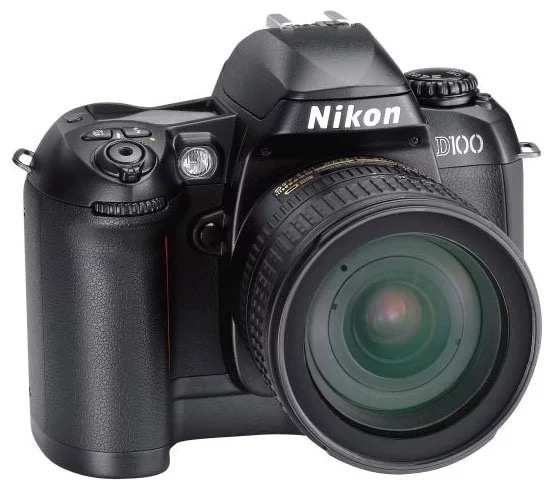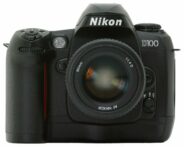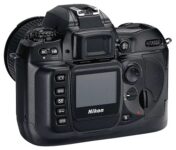Announced
Production status
System
Nikon F APS-C system cameras
- Nikon D1
- Nikon D100
- Nikon D1H
- Nikon D1X
- Nikon D200
- Nikon D2H
- Nikon D2Hs
- Nikon D2X
- Nikon D2Xs
- Nikon D300
- Nikon D3000
- Nikon D300s
- Nikon D3100
- Nikon D3200
- Nikon D3300
- Nikon D3400
- Nikon D3500
- Nikon D40
- Nikon D40X
- Nikon D50
- Nikon D500
- Nikon D5000
- Nikon D5100
- Nikon D5200
- Nikon D5300
- Nikon D5500
- Nikon D5600
- Nikon D60
- Nikon D70
- Nikon D7000
- Nikon D70s
- Nikon D7100
- Nikon D7200
- Nikon D7500
- Nikon D80
- Nikon D90
Nikon D100
APS-C AF digital SLR camera • Discontinued
Specification
| Format: | |
| APS-C | |
Imaging sensor: | 23.7 × 15.6mm CCD sensor |
Resolution: | 3008 × 2000 - 6 MP |
Crop factor: | 1.52x |
Sensor-shift image stabilization: | - |
| Nikon F [46.5mm] | |
| Shutter: | |
Type: | Focal-plane |
Model: | Electronically controlled |
Speeds: | 30 - 1/4000 + B |
| Exposure: | |
Exposure metering: | Through-the-lens (TTL), open-aperture |
Exposure modes: | Programmed Auto |
| Aperture-priority Auto | |
| Shutter-priority Auto | |
| Manual | |
| Physical characteristics: | |
Weight: | 700g |
Dimensions: | 144x116x80.5mm |
Manufacturer description
Amsterdam - Nikon Corporation has today announced a new addition to its D-series Digital SLR camera range. Named the D100, the camera has been developed to meet the demand for a multi-purpose, high-quality compact and lightweight digital SLR of exceptional value bearing the Nikon name.
The camera's target users include dedicated amateurs, business users and professionals who seek an approachable digital SLR camera of superb image quality and exceptional performance.
The D100 strengthens Nikon's digital range at the key mid-price point position and now means that the company offers a full line up of digital cameras from the 2 MP Coolpix models to the industry-standard D1X and D1H.
The D100 is compatible with the range of more than 40 AF Nikkor lenses as well as numerous speedlights and other accessories. Nikon's software has also been given attention with a new version of Nikon View for image transfer and management and Nikon Capture for camera control and advanced image processing.
The new Nikon D100 boasts sophisticated digital imaging technology, derived from the detailed definition of the 6.1 effective megapixel sensor, supported by an improved image-processing algorithm, and fine-tuned by an enhanced Auto White Balance system. It inherits exclusive, high-performance Nikon features such as 3D Matrix Metering, Five-Area Autofocus and a built-in Speedlight with D-TTL flash control capability. Based on the world-class F-mount, the D100 ensures compatibility with more than 40 AF Nikkor lenses for professional optical quality, as well as numerous other accessories including a dedicated Multi Function Battery Pack. The camera is supported by a strong software package that includes Nikon View for fast image transfer and management, and Nikon Capture 3 software that opens the potential of the Nikon NEF format as well as offering the excitement of remote control of the camera body. All of these features are packed in a stylish, compact and lightweight body for optimum portability. Packed with innovations and executed in a rugged and practical design, the Nikon D100 is certain to attract countless new digital SLR users to the world of Nikon digital SLR photography.
6-megapixel high-definition images
With the arrival of the D100, the benefits of choosing Nikon Digital - wide-ranging color, smooth tonal transitions, even gradation and breathtaking sharpness - are now within the reach of all photographers who seek the versatility of a Nikon digital SLR system.
This totally new Digital camera features a high-quality 6.1 million effective pixel sensor capturing ultra high-definition 3,008 x 2,000-pixel images that print at A3 format (297mm x 420mm) with rich colour and sharp detail. Housed within the rugged, purpose built body and complementing the high resolution CCD sensor is a new one-chip LSI for fast, power-efficient image processing.
Quality digital images - automatically
The Nikon D100 broadens the potential for Nikon digital SLR photography to encompass a wide range of business and personal photography needs. Its 3D Digital Matrix Image Control, features a newly developed image-processing algorithm to ensure faithful colour reproduction with smooth gradations that will reveal subtle details. The imaging system includes 3D Matrix Metering for precise exposure control, adaptive TTL White Balance for accurate color temperature determination and variable Tone Compensation for optimal tone and gradation . With a wide ISO range, low noise design and a built-in D-TTL Speedlight, the D100 will deliver Nikon total image quality from the widest range of shooting and lighting conditions : whether under total manual control or fully automatic operation.
High-performance Nikon SLR features
Confirmed Nikon SLR users will that find the D100's controls fall comfortably into place - those new to Nikon will discover the same ease of use that makes Nikon the choice of the world's most demanding professionals. The D100 employs ergonomics and advanced features inherited from Nikon Pro SLRs - including the acclaimed Five-Area Autofocus system, 10-segment Matrix Metering sensor and TTL Multi-Sensor. Based on the world-class F-mount, the camera accepts the full range of AF Nikkor lenses, as well as a variety of Speedlights including the latest SB-80DX for excellent D-TTL performance. Nikon digital SLRs set the world standard, and the D100 advances the application and potential of the Nikon system.
Digital photography that completes your vision
To fully explore the advantages of Nikon digital SLR photography with the Nikon D100, Nikon View 5 (supplied) enables easy transfer, preview and management of your images. Explore the potential of the Nikon Electronic File (NEF) raw file format, and discover making exposure control and white balance adjustments after, as well as before taking your picture. The new optional Nikon Capture 3 software takes productivity a stage further - photographic-specific image editing plus ability to create multiple edits without altering the original image data allow the full creative benefits of the NEF format to be realized.
Add to this the possibility to control the camera remotely from your computer, and the F-mount based Nikon D100 system - lenses, speedlights and software - combine to offer a Nikon Total Imaging System for all your photography needs. The Nikon D100 : digital performance redefined.
Nikon D100 Major Features
- 6.1 effective megapixels rendering 3,008 x 2,000-pixel images
- Compact and lightweight (weighs approx. 700g/24.7 oz.)
- Low-noise CCD sensor
- 3D Digital Matrix Image Control for precise exposure control, adaptive auto white balance and optimal color accuracy
- High-performance built-in Speedlight with D-TTL flash control
- Three color modes offered for different workflow environments
- Five-Area Autofocus with Dynamic AF operation
- High-speed image processing provided by new one-chip system LSI
- Top shutter speed of 1/4,000 sec. and flash sync speed up to 1/180 sec.
- Plug-and-play USB 1.1 interface for quick computer connection
- On-Demand Grid Lines can be displayable in viewfinder
- Custom Settings can be selectable in the LCD monitor
- Compatible with CompactFlash cards Type I and Type II including 512MB/1GB IBM MicroDrive
- Nikon View 5 software (supplied) enables easy transfer and viewing of images on your computer
- Optional Nikon Capture 3 software for excellent image management and remote operation
- Optional Multi Function Battery Pack MB-D100 accepts six 1.5V LR6 (AA-size alkaline) batteries or one or two Li-ion batteries for extended shooting capability. Features voice memo recording/playback function, vertical shutter release button, Command and Sub Command Dials, AF start button and a 10-pin remote terminal
Similar cameras (4)
APS-C • Auto focus • Digital • Singe-lens reflex • Nikon F mount
| Model | Shutter | Metering | Modes | Year |
|---|---|---|---|---|
| Fujifilm FinePix S1 Pro | E, 1/2000 | TTL • OA | PASM | 2000 ● |
| Fujifilm FinePix S2 Pro | E, 1/4000 | TTL • OA | PASM | 2002 ● |
| Fujifilm FinePix S3 Pro | E, 1/4000 | TTL • OA | PASM | 2004 ● |
| Fujifilm FinePix S5 Pro | E, 1/8000 | TTL • OA | PASM | 2006 ● |


